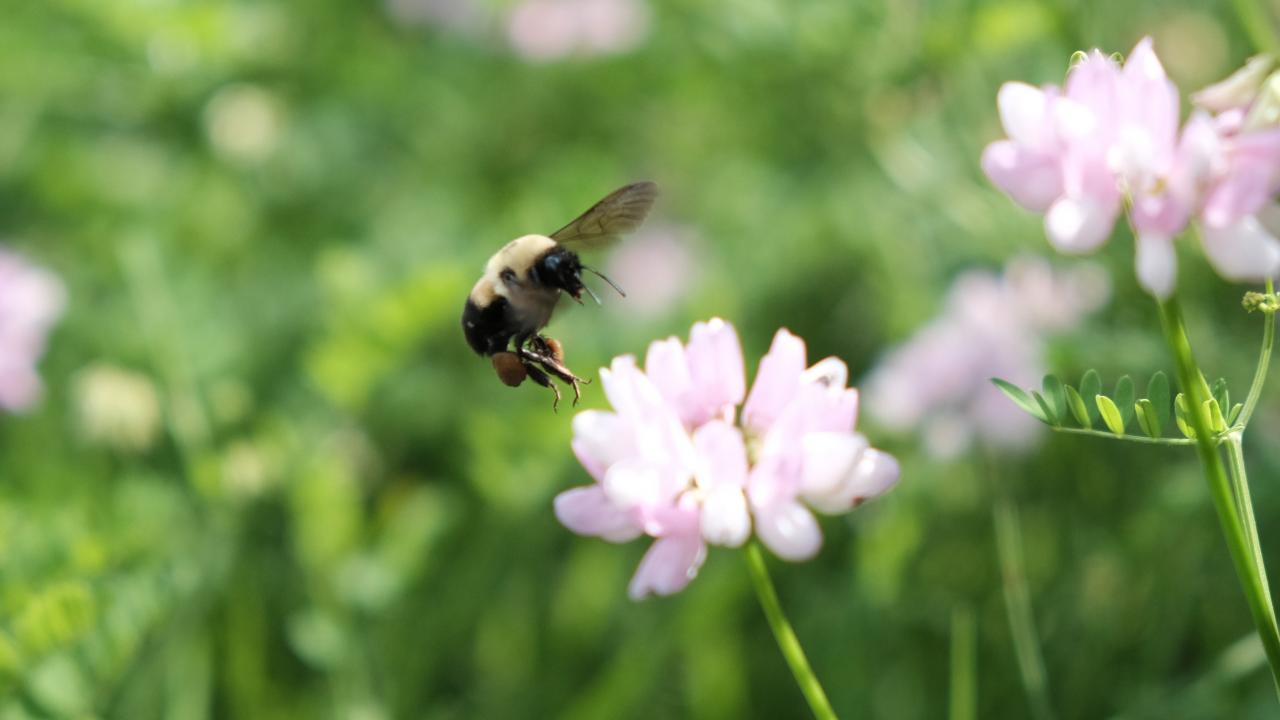
Social Bee-stortion: Exploring Pesticide’s Effects on Pollinators
Quick Summary
- Researchers observed the effects of imidacloprid, a pesticide, on bumblebee behaviors within the hive
- To study this hidden world, they outfitted bumblebees with tiny QR code tags and tracked individuals with video
- They found imidacloprid disrupts nest behavior, causing reduced growth in exposed colonies
A pesticide banned in the European Union but still in use in the United States is proving to have detrimental effects on pollinators. In a study appearing in Science, researchers show that the pesticide imidacloprid, which has been sold in the U.S. since 1994, disrupts bumblebee (Bombus impatiens) nest behavior, causing reduced growth in exposed colonies.
“We’ve known for a while that imidacloprid is bad for bumblebees and a number of bees,” said study co-author Stacey Combes, an associate professor of neurobiology, physiology and behavior at UC Davis. “This work adds another piece of strong evidence that these pesticides should be banned in the U.S., just like they are in the E.U.”
A look inside the hive
Imidacloprid is generally applied as a seed coating to protect crops and plants from being eaten by insects. While an effective deterrent against pests, it eventually spreads throughout the plant, manifesting in the pollen and nectar. This spells trouble for helpful pollinators like bees.
“There’s work showing that exposure to these pesticides reduces productivity, less queens are made and the hives don’t do as well overall,” said Combes, noting that previous studies have also explored the pesticide’s effects on behaviors outside the hive, showing a reduction in navigation skills. “This is the first time anyone has looked at behavior within the hive.”
To study behaviors within the hive, Combes and colleagues, led by Combes’ former graduate student James Crall, outfitted bumblebees with tiny QR code tags—a system called BEEtag—for identification purposes. They then dosed the bees with field-realistic concentrations of imidacloprid and monitored their subsequent behavior by video.
Less interactions, less productivity
The researchers found that chronic imidacloprid exposure led to a reduction in general activity and nursing rates within the hive. Bumblebees dosed with imidacloprid also congregated near the nest’s periphery rather than the center, leading to an overall reduction in their interactions with other bumblebees.
“The bees that are given more of these pesticides are basically just dropping out of these social networks,” said Combes. “As a result, a lot of the work that needs to be done in the hive is probably not getting done.”
According to Combes, only a handful of bumblebees in a colony actually go out and forage. The majority stay within the hive, where they take care of the young, feed the queen and tidy the hive.
“Bumblebee hives in particular are underground usually,” said Combes. “This study gives us a hint that the effects of imidacloprid on behavior are just as important to the hidden parts of their life cycle as they are to the visible parts.”
The team also found the pesticide’s effects on hive behavior were more pronounced at night and that nest workers couldn’t regulate the hives’ temperatures efficiently.
“In a lot of insects, if the brood are not exactly the right temperature, the offspring come out not nearly as skilled at learning or foraging, or they don’t survive,” said Combes.
Protecting backup pollinators
While honeybees have been the prime pollinators for agriculture, diseases like colony collapse disorder are wiping out their numbers, leading to concerns about stability. In light of this, many food producers and researchers are searching for backup pollinators.
“There’s more and more interest in bumblebees and native pollinators as a kind of backup to honeybees,” said Combes. “A lot of these native pollinators are much better pollinators than honeybees, so understanding how pesticides affect them is really important.”
This work was supported by the National Science Foundation, the Winslow Foundation, the Rockefeller Foundation, the Moore and Sloan Foundations and the Statistical and Applied Mathematical Sciences Institute, among other funding agencies.
Media Resources
- All videos provided by James Crall
